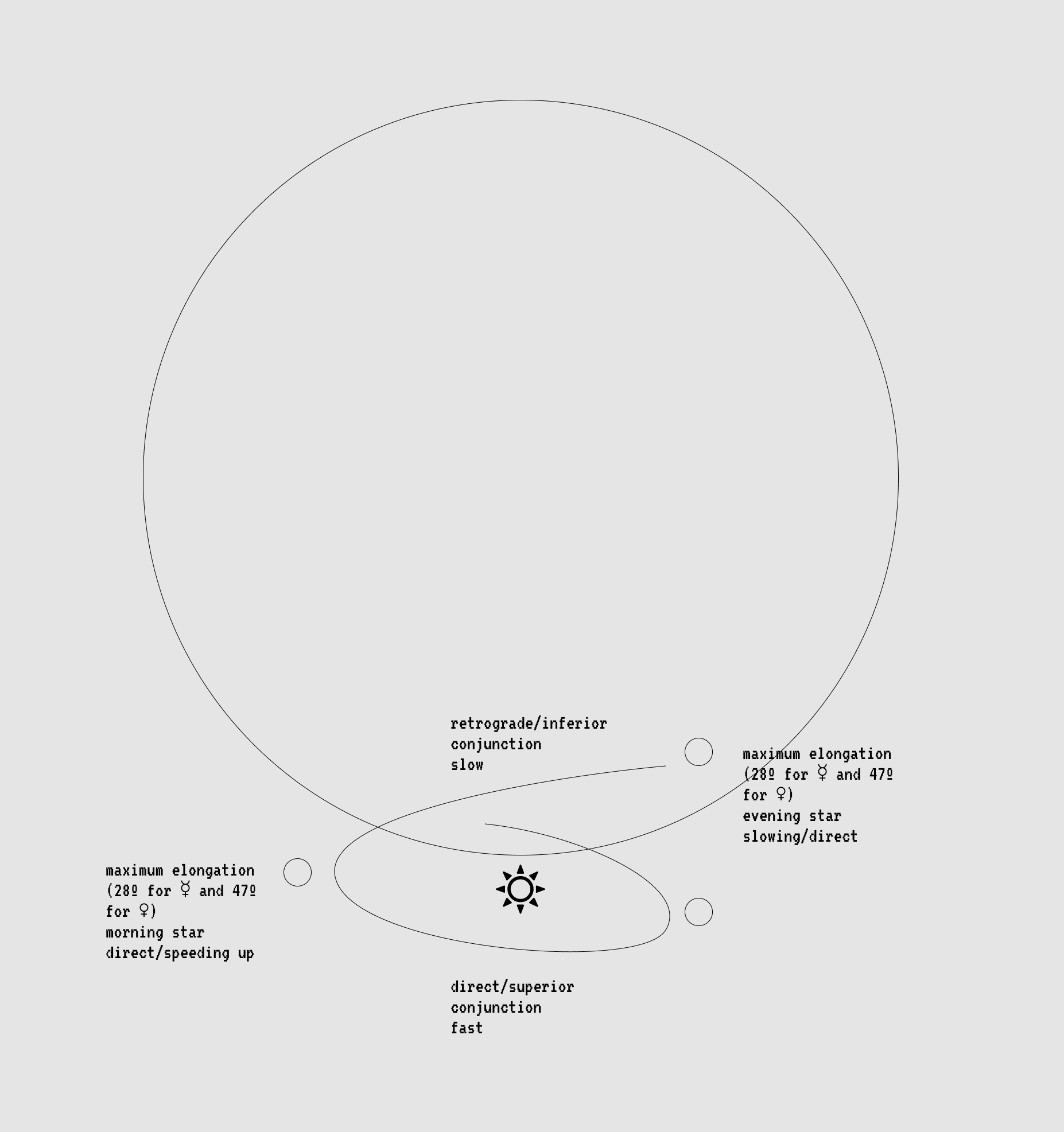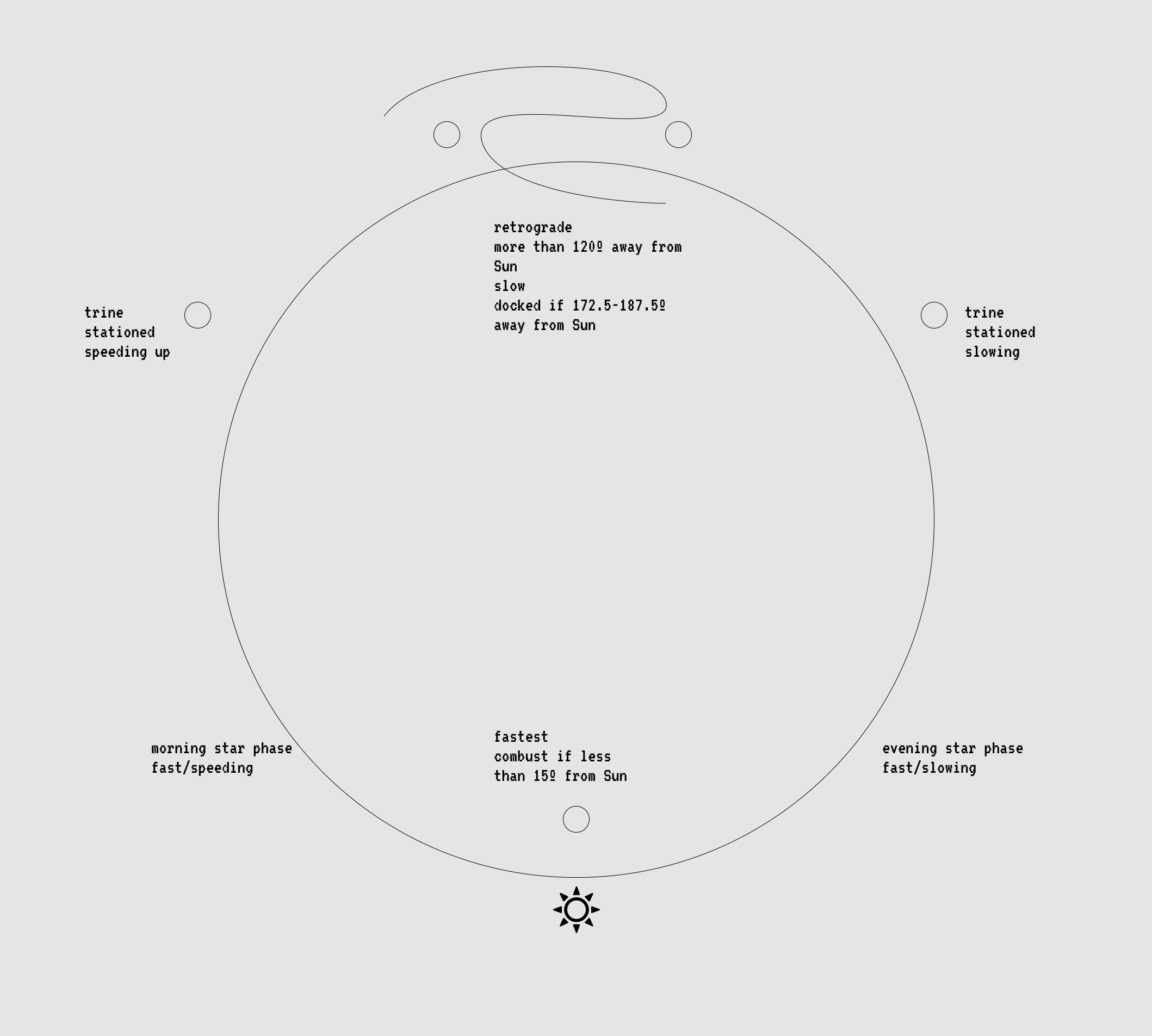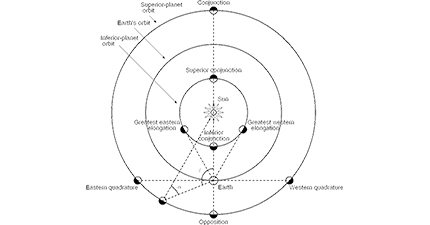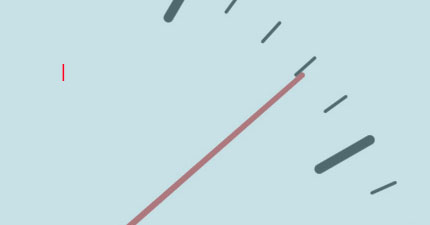There’s a huge basic difference between a Mercury or Venus retrograde and a retrograde of Mars, Jupiter, or Saturn. Retrogrades are all about visibility and, because Mercury and Venus are closer to the Sun than Earth, their cycles are completely different than the outer planets.
In this other article (linked), I already talked about how the order in which you have Sun, Mercury, and Venus matter because their retrogrades are part of a larger planetary cycle. When Mercury and Venus are emerging from a retrograde, they’re rising in the morning. When they’re about the retrograde, they’re rising in the evening.
Something that I didn’t get into in that article, because it was more focused on the zodiacal order of Sun, Mercury, and Venus was planetary speed and inferior vs superior conjunctions. Let’s talk about that here and then let’s talk about some things that people often underemphasize when examining the superior planets of Mars, Jupiter, and Saturn.
Inferior vs Superior Conjunction

This is a pretty simple concept. When Mercury or Venus are conjunct the Sun during its retrograde, it has an inferior conjunction with the Sun. This is because the planetary body is actually situated between the Sun and Earth. That’s why it’s called inferior—because it’s on the inferior side of the Sun.
When Mercury and Venus stop retrograding and conjunct the Sun again, direct, it’s actually doing so on the other side of the Sun. This is called a superior conjunction because they’re on the superior side of the Sun.
When we only think about a planet’s retrograde as it moving backwards in the sky from the Earth’s perspective, we neglect this very important relationship that it has with the Sun. When we get down to it, all the astrological techniques that we use have some kind of relationship with the Sun. Retrogrades don’t just happen in isolation from other factors. It’s a special relationship with the Sun.
Back to Mercury and Venus as evening star or morning star—there’s a special condition of either planet that occurs when it is too close to the Sun. This condition is called combustion. We’re really only able to see planets when they’re far enough from the Sun to show up in the night sky either right before the Sun rises or right after it sets. When a planet is too close to the Sun, it’s called combust because we simply are not able to see it through the Sun’s rays.
This burned out quality that Mercury and Venus both experience regularly during their planetary cycles is why both planets have such a strong mythological connection to death and resurrection. Hermes was between the living and dead worlds while Inanna, the original Venus goddess, had to descend into the underworld.
Planetary Speed
Mercury and Venus are slowest when they’re at inferior conjunction with the Sun, retrograding backwards which is considered the slowest of all motions. They’re fastest when they’re at superior conjunction with the Sun, proceeding directly forward.
When Mercury and Venus are at maximum elongation from the Sun, when they’re rising in the morning or evening and the furthest they can be from the Sun (for Mercury that’s 28º away and for Venus it’s 47º away) they’re stationed. And there are two types of station. There’s station direct that’s succumbing to a retrograde or emerging from one.
You can figure out whether your natal Mercury and Venus are retrograde, direct, about to retrograde, or emerging from a retrograde by consulting an ephemeris. Look at how many degrees away they are from your Sun, in what direction, and calculate whether they’re accelerating or decelerating based on how many degrees they move in the days surrounding your birthday. You won’t be able to figure this out through any natal chart calculator and will need to consult an ephemeris. I use the Astrolabe World Ephemeris but Astrodienst has some free PDFs available in their chart calculation section.
A planet that’s emerging from a retrograde is more optimistic than a planet that’s about to go into retrograde, which is more self doubting. A planet that’s retrograde and very slow is the closest it will be to the Earth. Likewise, a planet that’s very fast and direct is actually the farthest it can be from the Earth. How you might interpret this is up to you. Some astrologers say that retrogrades are more feminine (while the direct planets are more masculine), some that they’re unfortunate because a benefic will take back what it has given (while the direct ones give readily), and some that retrograde planets are simply more intense or emphasized because of the proximity with the Earth.
In a nutshell:
The order you have Sun-Mercury-Venus tells you a lot about your receptivity
Mercury and Venus are only visible when they’re far enough from the Sun to be visible in the night sky
Retrogrades of Mercury and Venus are the times when they’re closest to the Earth
Mercury and Venus move very fast and direct when they’re far from the Earth
Superior Planet Retrogrades

Any planet past Mars, including Jupiter, Saturn, Uranus, Neptune, and Pluto, is called superior because they’re on the superior side of the Sun. How they tend to retrograde is very different than the inferior planets.
Mars, Jupiter, and Saturn (and all outer planets past Saturn if you use those) only retrograde when they’re either in opposition to or near opposition to the Sun. That’s why, since 2018 when Jupiter, Saturn, and Pluto has been converging into one part of the zodiac wheel, they’re tended to retrograde together and during the summer around Cancer season. Since Pluto and Saturn are both in Capricorn, their slowest movements are when the Sun is in Cancer and, since Jupiter is in Sagittarius, it’s slowest movement is when the Sun is in Gemini. So, Jupiter retrogrades have happened a bit earlier than the Pluto and Saturn ones but they’ve definitely overlapped.
Of course, on the flip side of this is that, these outer planets will be at their fastest when the Sun conjuncts them. Winter of 2019, we’ll be seeing Jupiter, Saturn, and Pluto move at their fastest.
When Jupiter and Saturn are trine to the Sun they tend to station direct. That’s why, last month when the Sun was in Leo and we were celebrating all those fabulous birthdays, Jupiter in Sagittarius stationed direct. That’s also why, this month when the Sun is in Virgo and we’re getting ready to go back to school, Saturn in Capricorn will station direct.
Mars behaves a bit differently because, when Mars squares the Sun it tends to slow down drastically. But it’s still basically the same. It will station direct when it’s trine the Sun, or in a sign with the same element as the one that the Sun is currently in. That’s why Mars tends to retrograde every other year, since it takes a whole two years to go around the zodiac wheel. That’s also why it tends to cover a lot more ground when, like 2019, it’s moving with the Sun and a lot less ground, like 2018, when it’s moving far from the Sun. When it’s opposite the Sun on the zodiac wheel, it will retrograde for a large part of the year.
That’s why, right now, since the Sun is currently in Virgo, the bodies that are retrograde are Neptune in Pisces and Chiron in early Aries. Neptune is opposite the Sun and, while Chiron is not oppositional by sign it’s still not close enough to a trine. When the Sun reaches Scorpio and trines Neptune, we’re going to see it go direct.
Docked Planets
While the inferior planets, Mercury and Venus, suffer invisibility only once in their planetary cycles, the superior planets actually have two types of invisible conditions. One is the good ole combustion, when they’re at their fastest, and the other one is when they’re docked. Docked planets are retrograde and opposite the Sun so that the only time they are visible are during the dead of night. This makes them invisible (though they are technically visible in the night sky) because no one can actually see them unless they stay up very late at night (and no one wants to do that).
Think of it this way—if a planet is sufficiently far from the Sun then the Sun will have to be way on the other side of the world, or it has to be way late at night from where you’re situated, for the retrograde planet to be seen. The technical calculation for a docked planet is when it is anywhere from 172.5º to 187.5º from the Sun. But you could also just say that, well if you can’t see it and still maintain a normal bedtime then it’s invisible. A docked planet is in its slowest condition.
The superior planets can still be visible, or still rise as morning stars and set as evening stars, but they can’t be too far or too close from the Sun to do so. If they’re closer than 15º from the Sun then they become combust. If they’re 120º from the Sun then they start to station. So, superior planets are visible when they’re between 15-120º from the Sun. If you see them during the evening then they’re approaching a retrograde and decelerating. If you see them in the morning then they’re finishing a retrograde and accelerating.
Retrogrades of Superior Planets in the Natal Chart
If you have a planet retrograde in your birth chart, you actually experienced a planetary return when you were a baby. That’s right—people with Saturn retrograde went through their first Saturn return already when they were infants. This is obviously true of the inferior planets as well but, since we tend to experience those returns around our own birthdays, it makes less of a difference.
Another thing is, since you go through your first Mars, Jupiter, or Saturn planetary return as an infant when they’re retrograde in your natal chart, you get a second planetary return slightly later than everyone else. If Jupiter is retrograde in your chart, then you will get a second Jupiter return slightly after everyone else gets their first one. This might feel like a delayed puberty. If Saturn is retrograde in your chart, you get a second Saturn return slightly later than everyone else gets their first one. That’s why some people get their Saturn return when they’re twenty-seven and some people when they’re in their early thirties. It depends on the speed of Saturn in your natal chart. People who get their Saturn return a bit later than everyone else probably already had one, meaning that they dealt with Saturn issues as babies.
In a nutshell:
Planets are only considered visible in the sky, and powerful, when they’re between 15-120º from the Sun
Retrogrades of the outer planets only happen when they’re more than 120º away from the Sun (opposition or, if you use non-Plotemic aspects inconjunct by 150º)
Outer planets station when they’re in a sign of the same element as the Sun
You experience your first planetary return of a retrograde planet in the natal chart during infancy, which then delays your second return of that planet in relation to everyone who has the same planet direct


